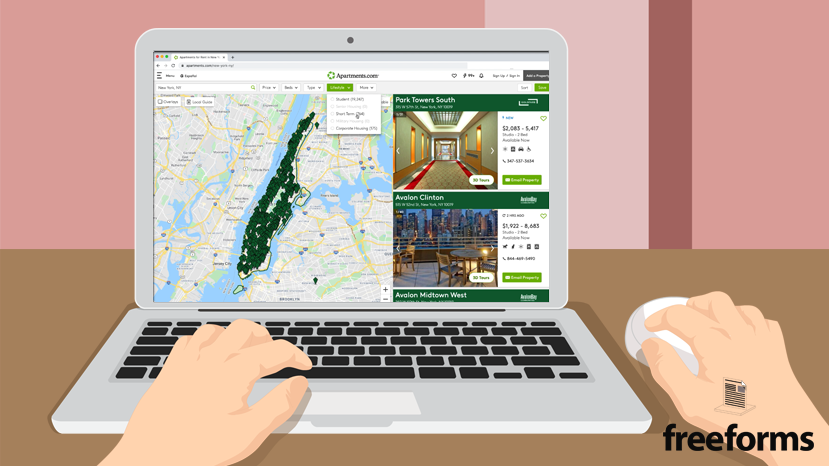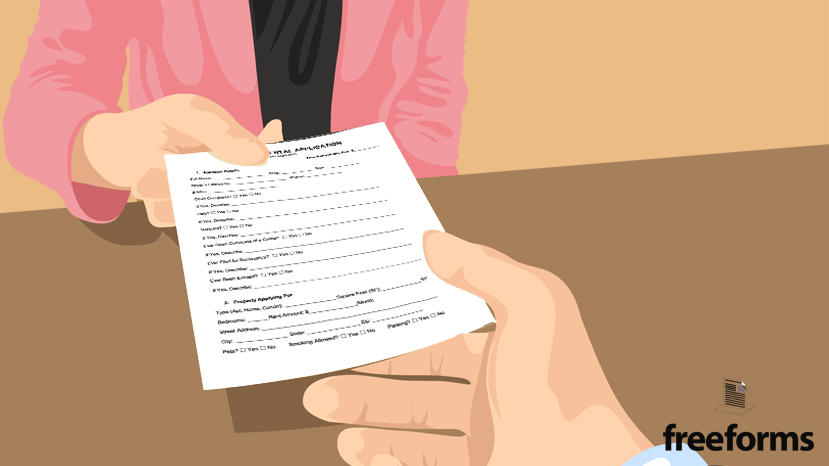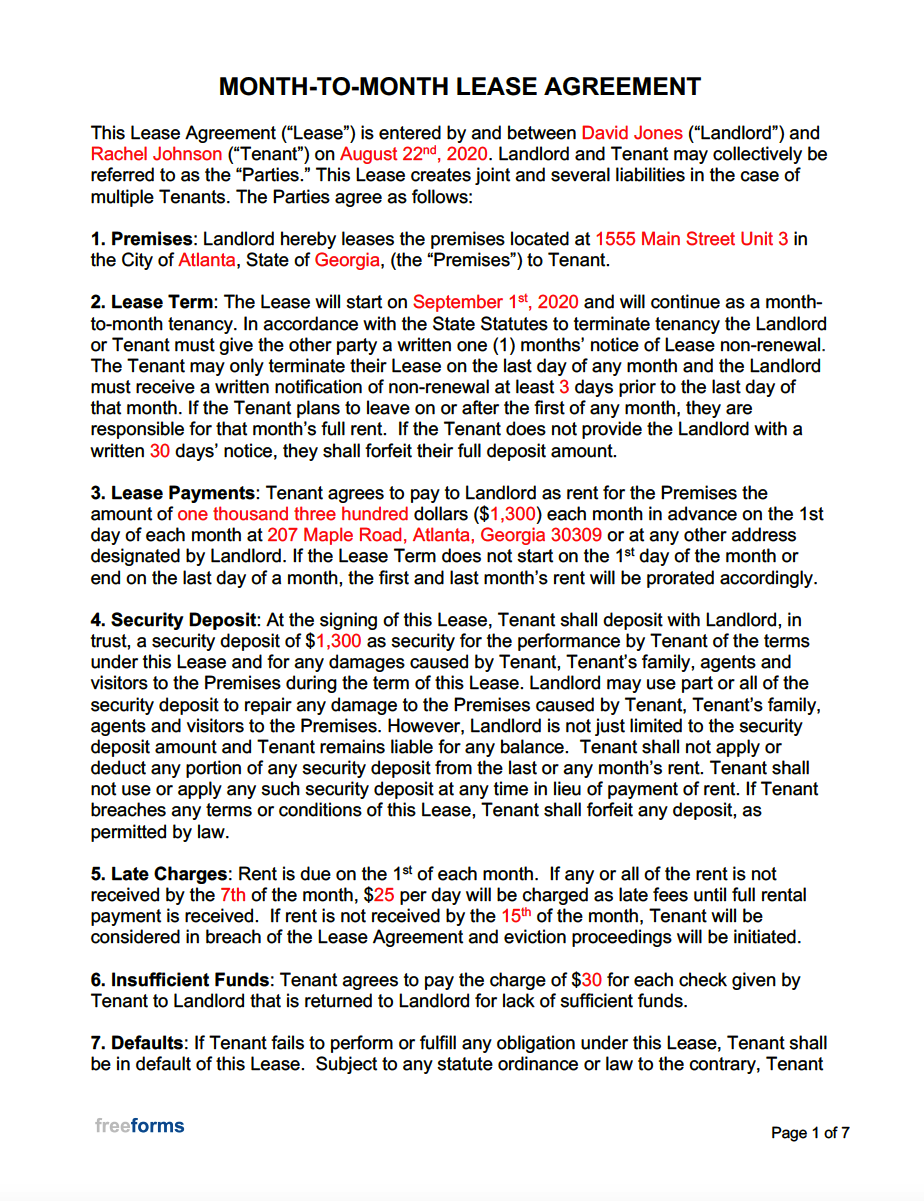Rental Application – Landlords utilize this document to ascertain whether or not a potential renter is qualified to lease their property.
By State
- Alabama
- Alaska
- Arizona
- Arkansas
- California
- Colorado
- Connecticut
- Delaware
- Florida
- Georgia
- Hawaii
- Idaho
- Illinois
- Indiana
- Iowa
- Kansas
- Kentucky
- Louisiana
- Maine
- Maryland
- Massachusetts
- Michigan
- Minnesota
- Mississippi
- Missouri
- Montana
- Nebraska
- Nevada
- New Hampshire
- New Jersey
- New Mexico
- New York
- North Carolina
- North Dakota
- Ohio
- Oklahoma
- Oregon
- Pennsylvania
- Rhode Island
- South Carolina
- South Dakota
- Tennessee
- Texas
- Utah
- Vermont
- Virginia
- Washington
- West Virginia
- Wisconsin
- Wyoming
What is a Month-to-Month Lease?
A month-to-month lease (also referred to as a “tenancy at will” or “periodic tenancy”) is a document that procures the rental of a property for about thirty (30) days at a time. It can be a useful tool for those who are not looking to commit to a yearly lease agreement. Given this information, it is not unheard of for a month-to-month tenancy to last for multiple years, as the contract will constantly renew at the end of each period until one of the parties terminates the agreement. In order to legally end the occupancy, users of the contract must follow their state’s guidelines that apply to this type of arrangement.
How Does it Work?
Whether you are a landlord trying to rent out your property on a month-to-month basis or a prospective tenant looking to secure a tenancy at will, this guide will take you step-by-step through each process of achieving a monthly rental arrangement.
Step 1 – Finding / Advertising a Month-to-Month Rental

As most properties will be on the market for an annual contract, you will want to find websites that allow users to filter the available homes so that only short-term rentals appear. The following sites allow visitors to narrow down their search options to just show periodic tenancies:
Step 2 – Showing / Viewing the Property

There will come a time when a prospective renter will request to view the property in person. It is important that both parties come prepared and on time. Preparations one could make before meeting up with the other party include:
For Landlords:
- Cleaning the Premises – Before showing the rental home, you are going to want to make sure that the unit is immaculate.
- Assembling the Paperwork – Have the necessary documents on hand, this would include a copy of the rental application, lease agreement, rules & regulations of the building, etc.
- Brainstorming the Property’s Selling Points – Even if you feel the property speaks for itself, it is always a good idea to highlight its strengths when showing the residence.
For Tenants:
- Devising Questions – Write down questions concerning any aspects of the property that are important to you.
- Gathering Documents – Separate yourself from the crowd and ensure that you have any documents that could verify your credentials and speed up the process. This may include multiple forms of identification, a credit report, pay stubs, etc.
- Having Funds Readily Available – If you wish to secure a rental as soon as possible, it is suggested that you have a certain amount of money accessible to cover the costs of any upfront payments, such as fees connected to the rental application, security deposit, rent, etc.
Step 3 – Rental Application

Any parties who viewed the rental property and showed interest should be given a copy of the rental application. Having a potential renter fill this out allows the landlord to receive personal details regarding the individual that can help evaluate their risk factor as a tenant.
The primary details that will need to be disclosed within the document include the occupant’s social security number, bank info, job title, and rental history. After filling out the form, signing it, and attaching a payment, it should be delivered back to the landlord for processing. The following websites offer services that facilitate the practice of screening a new resident:
- RentPrep.com – This option will probably give you the best bang for your buck with the basic package starting at $18.95 (supplementary add-ons also available for purchase).
- MySmartMove.com – Depending on the extensiveness of the screening, the cost of a report on this website can vary from $25 – $40.
- Zillow.com – The widely popular rental website “Zillow.com” offers certain screening services to its users (fees will vary depending on how deep you would like to investigate the applicant’s background).
- Experian.com – The cost of screening a tenant is very low on this site because it primarily covers their credit history.
Step 4 – Negotiate the Contract

Once the tenant has been deemed fit to rent, the parties should get together to hash out the details of the month-to-month lease agreement. Significant areas of the periodic tenancy that should be established consist of:
- Starting Date – On what day does the lessee have the right to move in and occupy the premises?
- Notice of Non-Renewal – How many days or months must the tenant give advance notice to terminate the contract? (This length of time must correspond with the minimum termination period imposed by the state in which the transaction is taking place.)
- Lease Payments – How much will be charged for rent each month?
- Security Deposit – The sum of money deposited by the lessee to protect the lessor from taking a hit on any damages or outstanding charges.
- Additional Fees – What will be the cost of any charges related to penalties or additional rights, e.g., late rent fee, returned check fee, pet fee, etc.
- Utility Costs – How will the utility expenses be divided? (i.e., who is responsible for each service?)
Step 5 – Executing the Month-to-Month Lease Agreement

Now that the parties have addressed the major components of the rental, it will be time to transfer the data to the legal form. Fill out the sections accordingly and then have each participant review the document to ensure that it contains all the necessary details. The lessor should present any required disclosure forms prior to signing, this would include:
- Lead-Based Paint Disclosure – Only mandated for properties constructed before 1978, this is to be furnished to any new occupants to inform them of the dangers associated with lead paint.
- Move-In/Move-Out Checklist – This is used to document the condition of the property before and after the occupancy to ensure that any deductions taken from the tenant’s security deposit are justified.
Once all the prerequisites have been met, the final step will necessitate the signatures of the lessor(s) and lessee(s). It only needs to be signed once, the contract will automatically renew each month without having to continuously provide signatures. Congratulations! You have now entered into a monthly rental contract.
Notice Required to Terminate Lease
| STATE | TERMINATION PERIOD | LAWS |
|---|---|---|
| Alabama | Thirty (30) Days | § 35-9A-441(b) |
| Alaska | Thirty (30) Days | § 34.03.290(b) |
| Arizona | Thirty (30) Days | § 33-1375(B) |
| Arkansas | Thirty (30) Days | § 18-17-704 |
| California | Thirty (30) days for individuals who have lived on the property for less than a year, sixty (60) days for those who have been tenants for a year or more. | § 1946 & § 827 |
| Colorado | Twenty-One (21) Days | § 13-40-107(c) |
| Connecticut | No Minimum | No Statute |
| Delaware | Sixty (60) Days | § 5106(d) |
| Florida | Fifteen (15) Days | § 83.57(3) |
| Georgia | Sixty (60) days’ notice must be delivered by the landlord, thirty (30) days’ notice by the tenant. | § 44-7-7 |
| Hawaii | Forty (45) days’ notice must be delivered by the landlord, twenty-eight (28) days’ notice by the tenant. | § 521-71 |
| Idaho | One (1) Month | § 55-208 |
| Illinois | Thirty (30) Days | 735 ILCS 5/9-207 |
| Indiana | One (1) Month | § 32-31-1-1 |
| Iowa | Thirty (30) Days | § 562A.34 |
| Kansas | Thirty (30) Days | § 58-2570 |
| Kentucky | Thirty (30) Days | § 383.695 |
| Louisiana | Ten (10) Days | § 2728 |
| Maine | Thirty (30) Days | § 6001 |
| Maryland | One (1) Month | § 8–402 |
| Massachusetts | Thirty (30) Days | § 186-15B |
| Michigan | One (1) Month | § 554.134 |
| Minnesota | One (1) Month | § 504B.135 |
| Mississippi | One (1) Month | § 554.134 |
| Missouri | One (1) Month | § 441.060 |
| Montana | Thirty (30) Days | § 70-24-441 |
| Nebraska | Thirty (30) Days | § 76-1437 |
| Nevada | Thirty (30) Days | § 40.251 |
| New Hampshire | Thirty (30) Days | § 540:2 |
| New Jersey | One (1) Month | § 2A:18-56 |
| New Mexico | Thirty (30) Days | § 47-8-37 |
| New York | Thirty (30) Days | § 232-b |
| North Carolina | Seven (7) Days | § 42-14 |
| North Dakota | Thirty (30) Days | § 47-16-15.5 |
| Ohio | Thirty (30) Days | 5321.17(B) |
| Oklahoma | Thirty (30) Days | § 41-111 |
| Oregon | Thirty (30) Days | SB 608 |
| Pennsylvania | Fifteen (15) Days | § 250.501 |
| Rhode Island | Thirty (30) Days | § 34-18-37 |
| South Carolina | Thirty (30) Days | § 27-40-770 |
| South Dakota | Thirty (30) days’ notice must be delivered by the landlord, fifteen (15) days’ notice by the tenant. | § 43-32-13 |
| Tennessee | Thirty (30) Days | § 66-28-512(b) |
| Texas | Thirty (30) Days | § 91.001(b)(2) |
| Utah | Fifteen (15) Days | § 78B-6-802(1)(b)(i) |
| Vermont | Thirty (30) days for tenants who have occupied the property for two (2) years or less, sixty (60) days for residents of more than two (2) years. | § 4467(e) |
| Virginia | Thirty (30) Days | § 55.1-1253(A) |
| Washington | Twenty (20) Days | § 59.18.200(1)(a) |
| West Virginia | One (1) Month | § 37-6-5 |
| Wisconsin | Twenty-Eight (28) Days | § 704.19(3) |
| Wyoming | No Minimum | No Statute |
Frequently Asked Questions (FAQ)
Is a Month-to-Month Lease a Good Idea?
Well, the answer to this question is relative to what the landlord or tenant is trying to achieve. Here are some of the beneficial factors associated with this type of rental agreement:
For Landlords:
- Higher Rent – Landlords who are willing to offer a month-to-month rental contract should be able to secure a higher rate of rent since there is less stability associated with this type of arrangement.
- Raise Rent – If they deliver adequate notice, lessors may also raise the rent at any time to take effect on the next payment date (only if the tenant agrees, otherwise, they may terminate the contract).
- Easy to Eliminate Tenants – Property owners who would like to expel certain occupants involved in a periodic tenancy, whether it’s because they are bad tenants or the landlord has received a better offer, can do so at any point as long as the proper amount of notice is delivered.
For Tenants:
- Minimal Obligation – Those who are not quite ready to commit to a year’s lease, whether they might have to relocate for work, need temporary housing while in between homes, or just like having the option to leave, this contract could be an ideal alternative to breaking a lease.
- No Specified Expiration Date – Even though this is considered a short-term contract, it could go on for years if both parties are satisfied with the arrangement.
- Good Option for Roommates – When you decide to split a residence with roommates, you are taking the risk of one of the individuals abandoning the premises. If it is a tenancy at will, the remaining tenant(s) can terminate the occupancy to avoid not being able to afford the rent and breaking the lease.
- Furnished – Many properties that offer a month-to-month option will already come equipped with furniture, this way, the tenant can avoid moving costs, buying new items, and the overall hassle of outfitting a rental property.
What Are the Cons of a Month-to-Month Lease?
As we already went over all the reasons as to why it may be a good idea to carry out the month-to-month lease agreement, here are some of the negatives linked to this type of contract:
For Landlords:
- More Vacancies – When offering this type of structure, tenants can terminate the contract during any month which may potentially result in more frequent vacancies.
- Less Effective Screening – The more turnovers attached to a rental unit, the more screening that will have to occur. If you have to rush the process in order to fill a property by a certain date, you may compromise the depth and overall effectiveness of the preliminary background check, thus resulting in less qualified tenants.
For Tenants:
- Inflated Costs – Monthly rentals where the lease is recurring can come with greater expenses, such as an increased rate of rent and/or additional fees for the short-term option.
- Less Stability – As the landlord has the right to end the tenancy at any time, the tenant may find themselves in a precarious situation if they aren’t prepared to move by the time mentioned in the termination letter.
How Do You Terminate a Month-to-Month Tenancy?
Most month-to-month rental contracts require a minimum of thirty (30) days’ notice to legally end the agreement. With that being said, most states have their own rules and regulations concerning the termination period of a tenancy at will. To properly terminate a periodic tenancy, the canceling party should:
- Review the Content of the Lease – Read through the lease agreement to see what the conditions entail for terminating the occupancy.
- Research Local Laws – Make sure that you know the state’s required amount of notice to rightfully cancel the contract. If the lease mandates a period that is less than the state’s minimum notice, then you may want to consider following the local legislation as opposed to the number of days given in the agreement.
- Send a Termination Letter – Deliver a termination letter by certified mail to the other party declaring that you wish to terminate the contract. Be sure to include your name, the date of termination, and your signature.
Can the Landlord Change the Terms / Raise the Rent on a Month-to-Month Lease?
The landlord has the right to alter the terms of the agreement at any time as long as proper notice is delivered to the tenant (most areas of the country require at least thirty (30) days). That being said, the tenant always has the option of rejecting the new changes and can back out of the contract if the landlord insists on making the modifications. If they do accept, the new terms will go into effect upon the following month.
Can an Eviction Occur with a Month-to-Month Lease?
Yes. A tenant that is squatting in a month-to-month rental property has to go through the same eviction process as someone who is unlawfully occupying a yearly rental. If they have already been delivered a notice to quit and haven’t responded, the only options for the landlord involve:
- Reviewing the Landlord-Tenant Laws – Do not attempt to remove the unwanted occupant(s) yourself. Read through your state’s landlord-tenant laws to better understand each party’s rights concerning this issue.
- Establishing Just Cause – Make sure the reason for eviction is legitimate. This is pretty cut and dry with periodic tenancies because if a landlord provides sufficient notice of termination and the tenant does not cooperate, then it is obvious that the tenant is in the wrong.
- Consulting with the Tenant – As long as it is not a hostile situation, try to reason with the squatting party. They may be more prone to leave after having a direct conversation with the landlord of the property.
- Sending an Eviction Notice – Before officially taking any legal action, the lessor may present the lessee with a notice of eviction warning them of what is to occur if they don’t vacate the property by a certain date. Hopefully, this will concern them enough to leave the property as soon as possible.
- Taking the Individual to Court – The final resort involves the landlord filing a formal eviction with their local courthouse. The parties will then receive a date in which they are to appear in court to state their case before a judge. As long as you have a valid case, the public official should rule in your favor and the squatter will be required to vacate the property within a certain timeframe. If they still refuse, they can forcibly be removed by the local sheriff’s office.
Sample Month-to-Month Lease Agreement
Download: Adobe PDF, MS Word (.docx)




